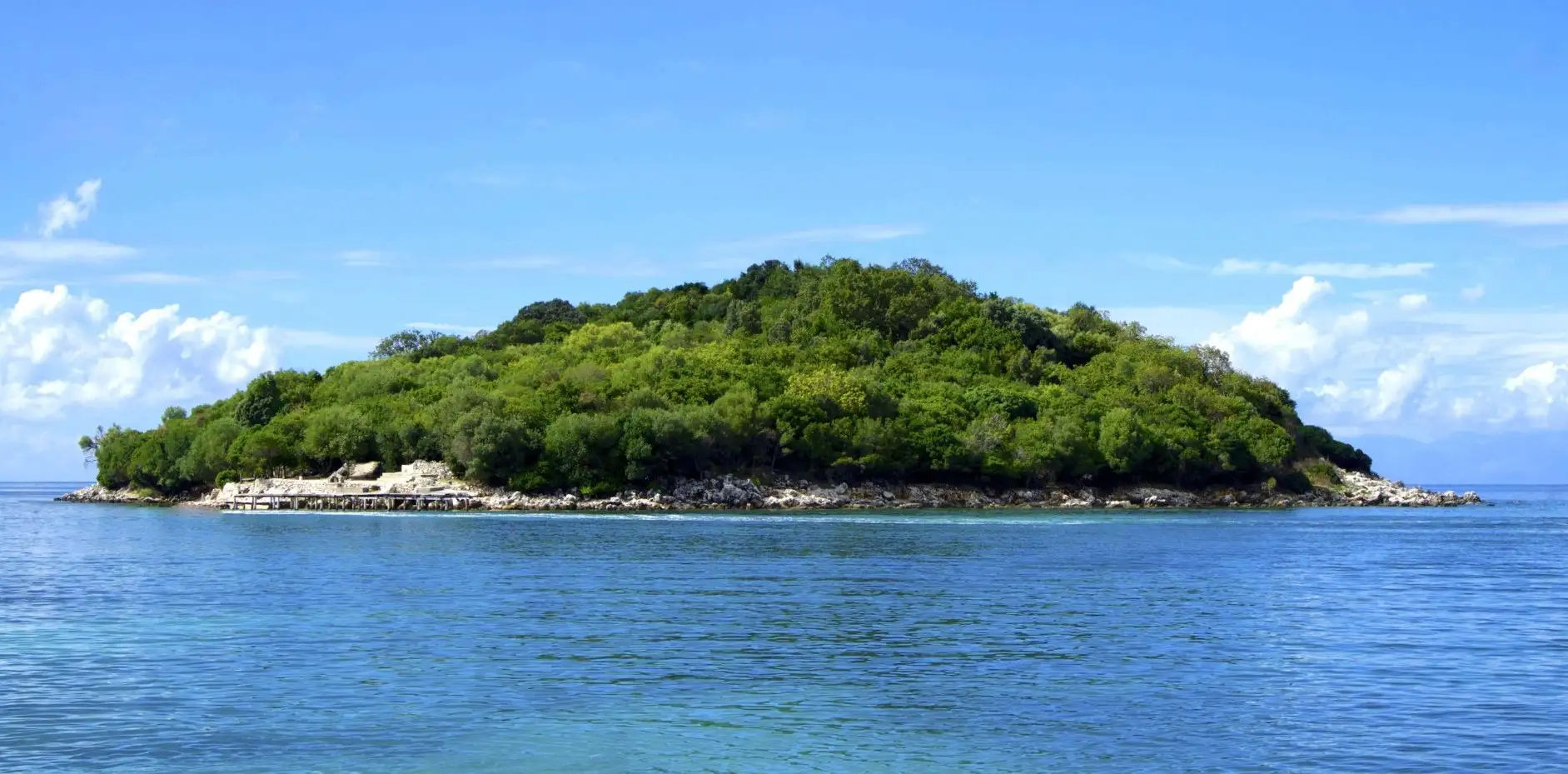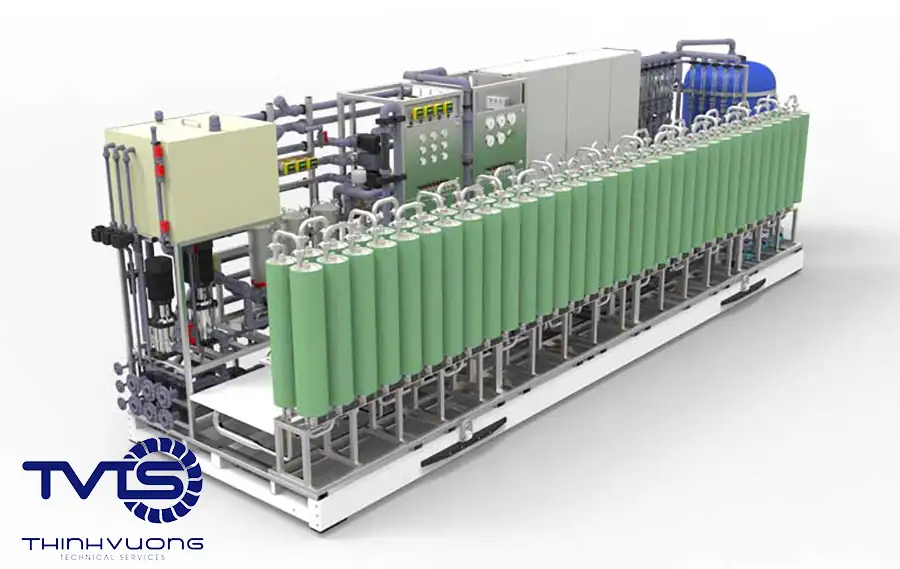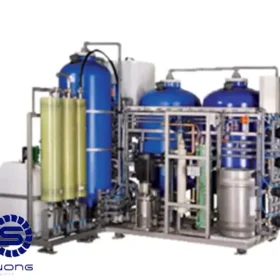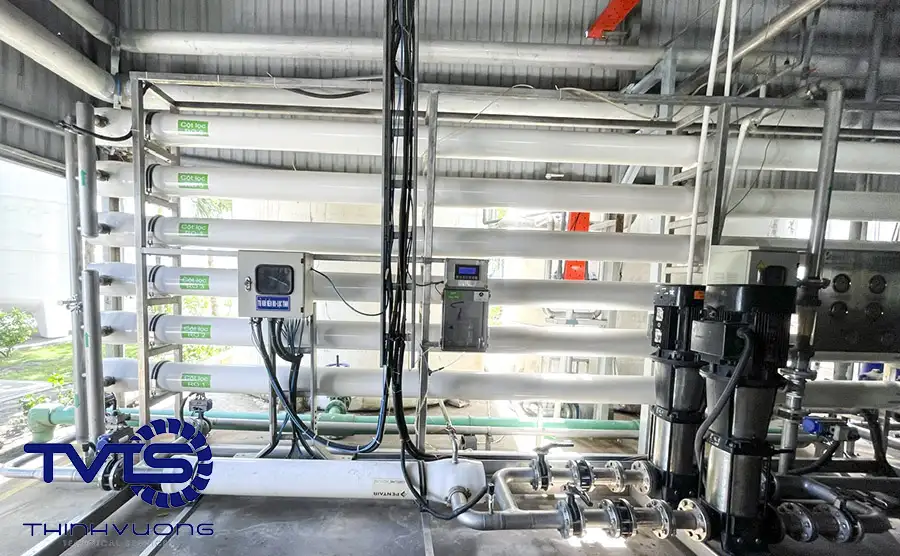Solutions for filtering seawater into fresh water, desalinating seawater and saline water provided by TVTS apply from small scale to medium and large scale factories.
Filtering seawater into fresh water is understood as the process of separating salt molecules from seawater solution. The resulting product is pure water or mineral water. TDS index below 500 ppm, meeting the standards for use as domestic or production water.
1. Is it really necessary to process seawater into fresh water?
With water scarcity becoming a serious and growing problem today, desalinating seawater to produce freshwater could be the key to creating a reliable source of drinking water.
To answer the question of whether filtering seawater into fresh water is really necessary? The creation of domestic water from the abundant water source that covers ¾ of the earth’s surface is very necessary and useful. Especially for islands and archipelagos that need to provide fresh water from the mainland. Filtering saltwater into drinking water will play an important role and contribute a huge meaning.

The equipment and technology for separating salt from salt water or saline water and producing fresh water will have different treatment efficiencies. The quality depends on:
- Requirements for clean water quality after treatment.
- Efficiency or rate of fresh water recovery from the equipment.
- Lifespan of the filter equipment.
- Initial investment cost.
2. Distinguish between seawater filtration system and saltwater to fresh water filter
The most obvious difference between a seawater filtration system and a seawater filter is the capacity. The capacity of the system is usually larger than that of a water filter. In general, these two terms refer to a device that can filter fresh water from salt water.
Comparison table between a seawater filter and a saltwater to fresh water filtration system at TVTS:
| Salt water filter | Salt water filtration system | |
| Capacity | 10 liters/hour to 500 liters/hour | 1000 liters/hour to 1,000,000 liters/hour (1000 m3/hour) and can be larger. |
| TDS allowed | < 25,000 ppm depending on customer requirements | < 45,000 ppm depending on customer requirements |
| Recovery rate | <30% | <45% |
2.1 Salt water to fresh water filtration system
The system of filtering salt water into fresh water is a water treatment process, including equipment and technology designed and installed at a construction site. Suitable for the purpose of use, climate and hydrogeological conditions in that area.
The seawater filtration system at a TVTS project has the following treatment process:
[Process of technology to filter water into fresh water]Description of the function of each seawater treatment technology
2.1.1 Pre-processing
– The raw seawater first passes through the pre-treatment stage of the system, and according to the extended limits for the SDI value range up to 20 %·min-1 (Scaling Index), only simple mechanical pre-treatment is required for this process.
– The pre-treatment stage consists of multi-layer sand filters, fine filters (10 µm cartridge).
2.1.2 Processing module
– Using the most advanced membrane material called TFC – Thin Film Composite of Polyamide/Polysulfone material. No chemicals are used for treatment, only acid or alkali is used to adjust the pH value. The treatment of seawater with the RO Module ensures a completely natural process and the quality of pure fresh water meets the standards without being affected by any chemical pollution.
– After passing through the high pressure pump and preliminary filtration steps, the seawater is fed into the RO Module. Here the water is analyzed with a ratio of 30-45% fresh. The salt water will be returned to the sea. After filtration, the fresh water is pumped up to the equalization tank at an altitude of +37m and integrated into the supply network built in phase I.
2.1.3 Membrane cleaning
– Depending on the high operating pressure, after about 600 to 800 hours of operation, the permeation membrane needs to be cleaned. The cleaning process is started with some normal operating steps such as switching valves, pouring cleaning chemicals into the tank. The cleaning sequences are automatically controlled by PLC. (In the construction of automatic membrane cleaning systems)
– For the cleaning process, only a harmless cleaning solution is used to remove blockages or other deposits.
In general, investing in a system to filter salt water into drinking water is quite expensive today. The cost for a filtration system with a capacity of 100 m3/day and night ranges from 10 billion to 20 billion VND.
The choice of filtration system depends on the quality of the water after treatment and the budget. Price follows quality. Only the most suitable and profitable price in terms of investment should be chosen, not the cheapest price.
2.2 Technology for treating salt water into domestic water at TVTS
Responding to the development trend and market demand for treating seawater into fresh water. TVTS Company provides equipment and RO membrane technology with TSRO and PFRO modules to filter seawater into fresh water that meets the standards of the Ministry of Health for drinking. Ensuring safety for daily life and production.
TSRO or PFRO modules are designed to be assembled into fixed or mobile seawater treatment systems. The system will be installed in factories with large capacity. However, we still meet small capacities depending on customer needs.

TVTS is a contractor specializing in providing design consulting services, construction solutions, technology proposals, and complete construction of seawater desalination systems. We will be the best choice for customers in the field of seawater filtration and saline water treatment.
The equipment used by TVTS for seawater treatment systems is mostly from European and American countries. Therefore, these systems are highly resistant to corrosion from seawater. The valve and pump control system is fully automatic, leak-proof and absolutely safe during operation.
2.3 Máy lọc nước mặn tại TVTS
In addition to the desalination system, TVTS also provides seawater filtration machines into drinking water with capacities from 1m3/day to 30m3/day. These devices provide clean water recovery rates from 20 to 50%.

When customers require water purifiers for families with smaller capacity. Please contact us directly for technical support and the best cost.
2.4 Share how to make your own saltwater filter (homemade).
Homemade seawater purifiers are mainly used in households that want to produce fresh water from seawater with small capacity. The principle applied in homemade seawater purifiers is water evaporation.
This device is the initiative of two female students Thu Ngan and Yen Linh – Hau Giang – in 2016.
Describe:
Seawater is pre-filtered and fed into the equipment to undergo the seawater evaporation process. The equipment includes:
- Container for seawater to be evaporated
- Black plastic sheet/cloth spread on the bottom of the tank to help the water absorb sunlight completely
- Glass, prisms and lenses to amplify the energy of sunlight
- Conductor tray and clean water tank created
This method has been applied by many poor people and has brought many benefits.
Homemade saltwater to fresh water filter with low cost. Brings many values to island households. However, the limitation of the filter is that it cannot be used on cloudy days and rainy days. Moreover, the life of the device has not been evaluated by a test table. It is easy to cause environmental pollution if the waste of the device after use is not strictly managed.
3. The most effective methods and technologies for filtering seawater into fresh water today
Technologies for filtering seawater into fresh water or filtering saltwater into drinking water are becoming more and more popular due to their urgency.
Some methods for filtering seawater into fresh water (or filtering seawater into drinking water/domestic water) are mentioned, such as:
3.1 Mechanical filtration method:
Mechanical filtration method is to use filter membrane to remove sediment particles, bacteria, dissolved salt molecules in water. Currently, the typical application of mechanical filtration method is reverse osmosis membrane technology RO.
RO (Reverse Osmosis) membrane technology is one of the important methods to filter seawater into fresh water. This is a mechanical filtration process that uses filter membrane to remove salt and impurities from seawater by applying pressure.

RO membranes are widely used in seawater treatment, filtering saltwater into fresh water or treating saltwater into domestic water.
RO membrane technology has many advantages, including high filtration efficiency and the ability to remove many different types of impurities. However, RO will use high pressure and consume energy, and require periodic maintenance of the filter membrane to maintain performance. RO membranes can also be clogged with impurities and need to be cleaned or replaced periodically.
There are many manufacturers and suppliers of RO membranes on the market. Prices are also very competitive. Choosing a reputable supplier is really quite difficult.
3.2 Distillation:
Low-pressure distillation: Using the low-pressure distillation method to turn seawater into steam, then condensing the heat source to condense the steam into fresh water. This process is called multi-stage distillation.
High-temperature distillation: Using high temperature to distill seawater into steam. Then take the steam and cool it to condense pure water.
The current technology applying the distillation principle is evaporators. The device works by compressing negative pressure and evaporating water from the salt solution. The product after the evaporation process is pure water and refined salt.
Although this technology helps to obtain both fresh water and salt, it is not widely used. The reasons revolve around expensive investment and operating costs. The operating process consumes quite a lot of energy.
3.3 Ion exchange:
Ion exchange is the process of using ions to precipitate with acid radicals to form salts in seawater. Specifically, the process uses ions such as calcium and magnesium to replace sodium ions, then removes the precipitated salts.
3.4 Solar energy:
The device to filter salt water into fresh water is based on the principle of liquid distillation and solar energy. The technology is commonly called Solar Desalination. The process of treating sea water with solar energy. By using solar energy to convert into electricity and heat energy. The salt water will also be evaporated and the result is pure water molecules and dry salt.
4. Some plants that filter seawater into fresh water in Vietnam
In the context of increasingly scarce clean water, desalination technologies and solutions are increasingly interested and focused. Although not among the countries with water shortages. But Vietnam has had a policy and implemented a plan to build and install seawater desalination stations to produce fresh water. With the purpose of serving the daily needs of island people. Some factories are mentioned as:
4.1 Seawater filtration plant into fresh water in An Binh commune, Ly Son island district (Quang Ngai).
The factory is a gift from Korea to the people of Ly Son island. Construction started in 2012.
Information about the factory producing domestic water from seawater in Ly Son island district:
- Capacity: 200 m3/day and night.
- Designed capacity of 200 m3 of seawater input. In fact, the current system can only operate at a capacity of less than 100 m3/day and serve the clean water needs of about 98 households (source: Tien Phong newspaper).
- Equipment supplier: Doosan Vina Company.
- In operation: 2012.
- Investment capital: 1 million USD.
4.2 Centralized water supply plant of Con Co island district, Quang Tri province, Vietnam
The water supply plant will install a system to treat seawater into fresh water and start construction at the end of 2022. It is designed with a capacity of 300 m3/day and night, with a recovery rate of 30-40%. Equivalently, when the system is operating, every 10 m3 of seawater will produce 3-4 m3 of fresh water.
- Applied technology: ROCHEM RO membrane from Germany. TSRO membrane module.
- Capacity: 300 m3/day and night.
- Installation location: Con Co island district, Quang Tri province,
- Vietnam.Supplier: Thinh Vuong Technical Services Joint Stock
- Company.Operation: 2023.
Contact us to discuss your specific project in more detail. Discover efficient and cost-effective desalination solutions that will help you achieve your goals.













